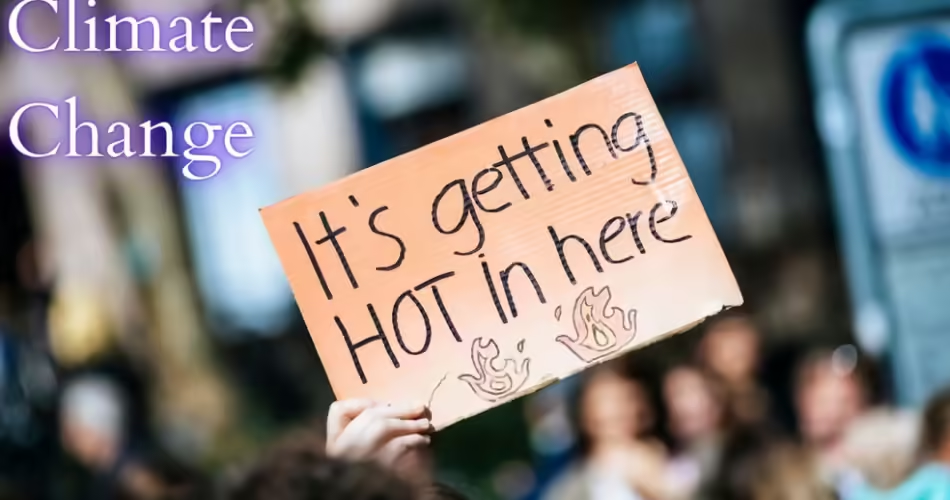This blog will provide you information about Climate Change. At first it will explain what is Climate Change. Secondly, it will elaborate the Natural and Anthropogenic drivers of Climate Change. At third place, this blog contain information about Impacts of Climate Change. At the end, this blog answers the question, How to adapt to Climate Change? It will explain adaptation and Strategies to adapt to Climate Change in detail. We will discuss the Drivers, Impacts and Adaptation of Climate Change in this blog.
1. What is Climate Change?
“It refers to the long-term shifts in temperature and weather patterns. These patterns may be natural and anthropogenic as well”.
Climate change has become a significant issue in past few decades.
In the past, there were very slow changes in the climate through passing years, but now climate change is on its extreme due to drastic changes in natural and anthropogenic climate change drivers.
Climate Change is effecting all types of lives on earth.
Every year extreme weather events are pointing out abrupt changes in the climate and it is dangerous for lives, resources and every other factor that effects life on earth.
This climate change is driven by natural changes in environment and human activities are contributing more than natural changes.
Climate change is leading too many problems for humans and animals on earth. We will discuss the drivers and impacts of Climate Change.
2. Drivers of Climate Change:
Following are some of the drivers of climate change:
Anthropogenic drivers of Climate Change:
i. Greenhouse Gases:
The main driver of climate change is Green House Gases (GHGs) emissions. These emissions were very low in concentrations before industrial era. But after the industrial era these emissions increased at a great extent and trapped by natural green house effect of the atmosphere. This increases the global warming and all the temperature-related impacts on life on earth. Main greenhouse gases include:
Carbon-dioxide CO2
Methane CH4
Nitrous Oxide N2O etc.
ii. Deforestation:
Forests are natural carbon sinks. When excessive forests are cut down then atmospheric carbon-dioxide is remains in the atmosphere. Cutting of the forests lead to increased concentration of CO2 and eventually result in global warming and rise in temperature.
iii. Excessive use of resources:
Natural resources may be renewable and non-renewable. Both of them are used for industrial, manufacturing and household purposes. With their availability, humans are using these resources carelessly and sustainability is not maintained. This creates lots of toxic gases in the atmosphere and deficiency of these resources for future generations. The reactions involved in their working, contributes in global warming, pollution and so it leads to more climate related problems.
Natural Drivers of Climate Change:
iv. Solar variations:
There are variations in the intensity of heat of the sun. It also includes the number of radiations reaching a region of earth and the sun spots found on the sun. Sun spots are in the result of changing magnetic field of the sun that is higher than anywhere else on the sun. By these variation, there is an increase in geomagnetic storm activity for earth. Increase in Northern lights and Southern lights is also one of its effects. It also cause disruption in radio transmission and power grids. In this way it effects and promotes climate change.
v. Volcanic Eruptions:
When the gases or lava are released from a volcano this is called volcanic eruption. This can be explosive and can cause dangerous effects to living organisms. These eruptions contains hot gases and when erupted, they are added in the atmosphere. This results in the increase in temperature and contributes in global warming. With these gases, aerosols and ashes are also added to the atmosphere that works for trapping heat in the atmosphere and warms the earth.
vi. Livestock Farming:
Livestock farming is the process raising livestock for various purposes like providing clothing, food, and even for pleasure and so it contributes 16.5% of GHG pollution. Two greenhouse gases that adds to greenhouse gases by livestock farming are methane and nitrous oxide. In this way it contributes a lot in global warming and rise in Earth’s temperature.
These are the Natural and Anthropogenic Drivers of Climate Change, now we will discuss the impacts.

3. Impacts of Climate Change:
Following are some of the impacts of climate change:
• Hazardous Air Quality:
Due to excessive Green House Gases (GHG) emissions the air quality is being hazardous from past few decades. It is enhancing air pollution day by day and contributing in rise of temperature.
• Melting of glaciers:
Rise of temperature is causing the melting of ice sheets of polar region so the water from the glaciers is adding into the sea and sea-level is rising and coastal areas are under great pressure.
• Changes in Rainfall Patterns:
Changes in temperature cause changes in rainfall patterns so this effects the weather patterns. In this way the seasonal crops and other essential things are disturbed.
• Heath issues:
Many health issues have come across due to rise in temperature and extreme weather patterns. This may lead to extreme health conditions and increased fatality rate every year.
• Hazardous Environmental Conditions:
These changes in climate and weather events are becoming hazardous every year. Floods, storms and sand storms are increasing every year due to these changes in climatic conditions.
• Water Scarcity:
High temperature leads to high evaporation rates for freshwater and groundwater reservoirs so in this way we are losing freshwater and our water table is declining and water is not enough for agriculture and daily use of people.
Climate change is disturbing every field of life in every way so these are the impacts of Climate Change on Environment, we can relate them with drivers of Climate Change.
3.How to adapt to Climate Change?
What is Adaptation?
Adaptation refers to the ability of a system to adjust to climate change in order to reduce is vulnerability, and enhance the resilience to observed and anticipated impacts of climate change.
IPCC (Intergovernmental Panel on Climate Change) defines adaptation as “adjustment in natural or human systems to a new or changing environment. Adaptation of climate change refers to adjustment in natural or human systems in response of actual or expected climatic stimuli or their effects, which moderates harm or exploits beneficial opportunities“.
Adaptation occurs in physical, ecological, and human systems. It involves the following.
- Changes in social and environmental processes
- Perceptions of climate risk
- Practices and functions to reduce risk
- Exploration of new opportunities to cope with the changed environment.
In other words, adaptation can be understood as an ongoing process addressing man’s factors and stresses, rather than just climate change in specific.
The severity of an event in a system depends on the coping range and the resilience range. The following diagram shows the severity of an event in two scenarios. The two scenarios are as follows.
1. In the absence of adaptation measures:
It depicts that when there are no adaptation measures, then with the increase in event severity, the coping and resilience ranges decrease and the failure range increases, thereby making the system more and more susceptible to the impacts of climate change.
2. In the presence of adaptation measures:
It depicts that when adaptation strategies are in place, then with the increase in event severity, the coping and resilience ranges increase and the failure range decreases.
In short, a system with adaptation measures will be more resilient to damage in case a severe event takes place. This system will suffer lesser damage in an event with same level of severity, compared to another system without adaptation measures.
Individually, each person must take responsibility for his or her own contribution to global climate change. Small incremental changes, based on individual choices, can add up to substantial change. Individuals should consider, whenever possible, choosing a fuel-efficient car, reducing automobile use, making their home more energy-efficient, planting trees, recycling, and reducing consumption.
Adaptation Measures against Climate Change:
Individuals have a responsibility to learn more about climate change and educate others. In democratic nations individuals should insist that political candidates reveal their views on climate change and its mitigation and adaptation choose those candidates who are well informed.
Following are the adaptation measures for climate change:
- Desalination
- Integration of climate change adaptation using land use change.
- Rehabilitation and Restoration of rivers.
- Water sensitive Forest Management.
- Adaptation of Groundwater Management
- Establishment and restoration of riparian buffers.
- Economic incentives for Behavioral Change.
- Afforestation and Reforestation as adaptation opportunity.
- Urban green infrastructure planning and nature-based solutions.
The exact impacts of climate change are not, and may not be, totally predictable. So why take mitigative actions that may be expensive in the face of uncertainty? There are several reasons that argue in favor of acting sooner rather than later.
First, although exact effects are not predictable and could in some instances be minimal, it is also true that such uncertainty means that effects could be very serious or even catastrophic.
Second, we have already committed the Earth to significant climate change, so the longer we wait to substantially reduce GHG emissions, the more serious, difficult, and expensive that change will be.
Third, many of the suggested mitigative measures, such as increased energy efficiency, will have positive environmental (e.g. improved air quality) and economic benefits.
Finally, we have a responsibility to future generations to hand over the planet with a climate that can sustain the quality of life that we ourselves have experienced, rather than a planet with a serious problem requiring huge costs to repair.
4.Conclusion:
Climate change was near to negligible before few decades. But due to human activities, this is increasing every year and now it has reached to the alarming level. This cannot be ignored anymore. If it will be ignored, it will be life threatening and the issues will be unbearable in few years. We are losing our freshwater because of extreme pollution and extreme weather events. Countries are exposed to drought and water scarcity every year. We should apply adaptation and mitigation in order to control and limit this climate change. By reducing and preventing the damage by drivers of Climate change we can reduce the impacts at a great level.

To learn about more topics, click the links below:


Comments